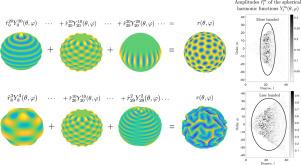基于球谐波的伪频谱方法,用于定量分析软核壳起皱过程中对称性破坏的情况
IF 6.9
1区 工程技术
Q1 ENGINEERING, MULTIDISCIPLINARY
Computer Methods in Applied Mechanics and Engineering
Pub Date : 2024-11-13
DOI:10.1016/j.cma.2024.117529
引用次数: 0
摘要
由于分析方法和当前数值方法的局限性,要完全理解曲面基底上压缩薄膜的起皱现象仍是一个未知数。产生这些困难的原因是,变形局部的能量最小分布主要受固有非线性的影响,而且曲面上的变形模式还受到拓扑结构的限制。在球形等没有球形对称离散的领域中,需要密集的网格来缓解离散的拓扑限制,而由于非线性,需要在高度非凸的能量景观中密集搜索最小值,这两个因素的结合使得现有的数值方法在计算上不切实际,而不需要过度简化假设来降低计算成本,或引入人为参数来确保数值稳定性。为了解决这些问题,我们开发了一种新型(较少)简化版壳理论,用于承受膜载荷(如起皱时)的壳。它将通常被排除在外的切向位移的线性贡献纳入膜应变能中,从而在几乎达到完整的 Kirchhoff-Love 壳理论精度的同时,保留了最先进的简化方法的计算效率。本文章由计算机程序翻译,如有差异,请以英文原文为准。

Spherical harmonics-based pseudo-spectral method for quantitative analysis of symmetry breaking in wrinkling of shells with soft cores
A complete understanding of the wrinkling of compressed films on curved substrates remains illusive due to the limitations of both analytical and current numerical methods. The difficulties arise from the fact that the energetically minimal distribution of deformation localizations is primarily influenced by the inherent nonlinearities and that the deformation patterns on curved surfaces are additionally constrained by the topology. The combination of two factors – the need for dense meshes to mitigate the topological limitations of discretization in domains such as spheres where there is no spherically-symmetric discretizations, and the intensive search for minima in a highly non-convex energy landscape due to nonlinearity – makes existing numerical methods computationally impractical without oversimplifying assumptions to reduce computational costs or introducing artificial parameters to ensure numerical stability. To solve these issues, we have developed a novel (less) reduced version of shell theory for shells subjected to membrane loads, such as during wrinkling. It incorporates the linear contributions of the usually excluded tangential displacements in the membrane strain energy and thus retains the computational efficiency of reduced state-of-the-art methods while nearly achieving the accuracy of the full Kirchhoff–Love shell theory.
We introduce a Galerkin-type pseudo-spectral method to further reduce computational costs, prevent non-physical deformation distribution due to mesh-induced nucleation points, and avoid singularities at the poles of the sphere. The method uses spherical harmonic functions to represent functions on the surface of a sphere and is integrated into the framework of minimizing the total potential energy subject to constraints. This robust approach effectively solves the resulting non-convex potential energy problem. Our method accurately predicts the transition between deformation modes based solely on the material and geometric parameters determined in our experiments, without the need to introduce artificial parameters for numerical stability and/or additional fitting of the experimental data.
求助全文
通过发布文献求助,成功后即可免费获取论文全文。
去求助
来源期刊
CiteScore
12.70
自引率
15.30%
发文量
719
审稿时长
44 days
期刊介绍:
Computer Methods in Applied Mechanics and Engineering stands as a cornerstone in the realm of computational science and engineering. With a history spanning over five decades, the journal has been a key platform for disseminating papers on advanced mathematical modeling and numerical solutions. Interdisciplinary in nature, these contributions encompass mechanics, mathematics, computer science, and various scientific disciplines. The journal welcomes a broad range of computational methods addressing the simulation, analysis, and design of complex physical problems, making it a vital resource for researchers in the field.

 求助内容:
求助内容: 应助结果提醒方式:
应助结果提醒方式:


